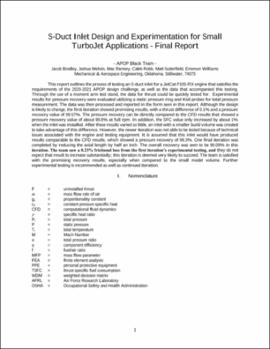| dc.contributor.author | Williams, Emerson | |
| dc.contributor.author | Bradley, Jacob | |
| dc.contributor.author | Melvin, Joshua | |
| dc.contributor.author | Ramsey, Mac | |
| dc.contributor.author | Robb, Caleb | |
| dc.contributor.author | Sutterfield, Matt | |
| dc.date.accessioned | 2021-05-25T19:44:37Z | |
| dc.date.available | 2021-05-25T19:44:37Z | |
| dc.date.issued | 2021-05-07 | |
| dc.identifier | oksd_williams_HT_2021 | |
| dc.identifier.uri | https://hdl.handle.net/11244/329886 | |
| dc.description.abstract | This report outlines the process of testing an S-duct inlet for a JetCat P100-RX engine that satisfies the requirements of the 2020-2021 APOP design challenge, as well as the data that accompanied this testing. Through the use of a moment arm test stand, the data for thrust could be quickly tested for. Experimental results for pressure recovery were evaluated utilizing a static pressure ring and Kiel probes for total pressure measurement. The data was then processed and reported in the form seen in this report. Although the design is likely to change, the first iteration showed promising results, with a thrust difference of 0.1% and a pressure recovery value of 99.57%. The pressure recovery can be directly compared to the CFD results that showed a pressure recovery value of about 99.8% at full rpm. In addition, the SFC value only increased by about 1% when the inlet was installed. After these results varied so little, an inlet with a smaller build volume was created to take advantage of this difference. However, the newer iteration was not able to be tested because of technical issues associated with the engine and testing equipment. It is assumed that this inlet would have produced results comparable to the CFD results, which showed a pressure recovery of 99.3%. One final iteration was completed by reducing the axial length by half an inch. The overall recovery was seen to be 99.09% in this iteration. The team saw a 0.23% frictional loss from the first iteration's experimental testing, and they do not expect that result to increase substantially; this iteration is deemed very likely to succeed. The team is satisfied with the promising recovery results, especially when compared to the small model volume. Further experimental testing is recommended as well as continued iteration. | |
| dc.format | application/pdf | |
| dc.language | en_US | |
| dc.rights | Copyright is held by the author who has granted the Oklahoma State University Library the non-exclusive right to share this material in its institutional repository. Contact Digital Library Services at lib-dls@okstate.edu or 405-744-9161 for the permission policy on the use, reproduction or distribution of this material. | |
| dc.title | S-duct inlet design and experimentation for small turbojet applications: Final report, APOP Black Team | |
| osu.filename | oksd_williams_HT_2021.pdf | |
| osu.accesstype | Open Access | |
| dc.type.genre | Honors Thesis | |
| dc.type.material | Text | |
| thesis.degree.discipline | Mechanical and Aerospace Engineering | |
| thesis.degree.grantor | Oklahoma State University | |
